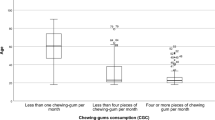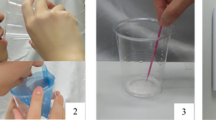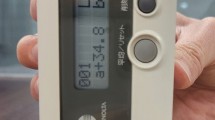Abstract
The purpose of this study was to clarify the inter-measurement variation of the masticatory performance test. Forty healthy adults were divided into group A (10 males and 10 females), who did not chew the test food before experiment, and group B (10 males and 10 females) who chewed the test food before the experiment. Subjects were asked to chew a gummy jelly for 20 s on the habitual chewing side, and the amount of glucose extraction was measured. The test was repeated three times with an interval of 1 min in both groups (Group A: A1, A2, A3; Group B: B1, B2, B3). In both groups A and B, the difference between the measured values was compared and the reliability between measurements was investigated. In group A, the value of A1 was small, and a statistically significant difference was observed between A1 and other measured values. In group B, the three measured values were similar and no significant difference was observed among the measured values. The intraclass correlation coefficient (ICC) values for determining inter-measurement reliability in group A were 0.758 for A1–A2–A3, 0.708 for A1–A2, and 0.901 for A2–A3. The ICCs in group B were 0.924 for B1–B2–B3, 0.945 for B1–B2, and 0.926 for B2–B3. Based on these results, it can be suggested that high reliability between the measurements can be obtained if the subjects are accustomed to chewing the test food before the experiment, and that the measured values were similar whether it was performed two or three times. Consequently, one measurement was sufficient if subjects were accustomed to chewing the test food before the experiment.
Similar content being viewed by others
Avoid common mistakes on your manuscript.
Introduction
Many attempts have been made to extend the healthy life expectancy and maintaining and improving oral function is extremely important to achieve this. In order to maintain healthy oral function, it is necessary to have good masticatory function. Masticatory function has been reported to decrease due to tooth loss [1, 2] and improve with dental treatment [3, 4]. Masticatory performance has been listed as an important parameter for objectively evaluating masticatory function. Therefore, many methods have been reported to objectively evaluate the masticatory performance. Among these, the masticatory performance test, which measures the amount of glucose extraction after chewing a gummy jelly, is simpler than the conventional sieving method, and the results can be obtained quickly; therefore, it is used in clinical settings [5,6,7,8].
However, the number of measurements required for the masticatory performance test has not been often described, and it varies from two to five times for multiple measurements [3, 5, 6, 9,10,11,12,13,14,15] with no definite consensus at present. For the multiple measurements, three times was the most frequently reported number [3, 6, 9, 13, 14]. It can be attributed to the fact that it is not clear whether the masticatory performance should be measured only once or repeated, and how many times.
Therefore, in this study, in order to clarify the inter-measurement variation in the masticatory performance test, the masticatory performance test using a gummy was performed three times, and the measured values were analyzed. Examining the inter-measurement variation of masticatory performance test is clinically significant because it could help clarify the number of the test when evaluating masticatory performance.
Materials and methods
Ethic statement
This study was conducted in accordance with the principles of the Declaration of Helsinki. All experimental procedures were approved by the Ethics Committee of the Nippon Dental University (approval number: NDU-T2020-31). The content of the experiment was fully explained to each subject, and the experiment was performed after obtaining consent.
Subjects
Forty healthy subjects (20 men, 20 women; average age 31.1 ± 4.7 years) participated in the study. The inclusion criteria were as follows: (1) no clinical abnormalities in the masticatory system, (2) natural dentition, with the possible exception of the third molars, and (3) no complaints related to occlusion. The exclusion criteria were as follows: (1) previous/current orthodontic treatments, (2) currently undergoing dental treatment, and (3) signs or symptoms of TMD and/or orofacial pain.
Test food
A gummy jelly (GC, Tokyo) having a diameter of 14 mm, height of 8 mm, and weight of about 2 g was used as the test food.
Recording method
For the experiment, 40 subjects were first divided into group A (10 males and 10 females) and group B (10 males and 10 females). In group A, the habitual chewing side was determined by an interview by asking the subjects on which side it was easier to chew. Next, the amount of glucose extraction when the subject chewed the gummy jelly on the habitual chewing side for 20 s was measured. Group B was explained that they were to chew gummy jelly before the experiment to get used to the taste and hardness of the test food. Except for this point, the measurement procedures of groups A and B were the same. In group B, after a gummy jelly was freely chewed before the experiment, the habitual chewing side was determined by an interview. Subsequently, the amount of glucose extraction when the subject chewed the gummy jelly in the same manner as in group A was measured. The measurement was repeated three times with an interval of 1 min in both groups A and B (Group A: A1, A2, A3, Group B: B1, B2, B3).
Measurement of amount of glucose extraction
Subjects were asked to chew a gummy jelly on one side for 20 s and then were asked to hold 10 mL of water in their mouth and to spit into a cup with a filter. Then, the filtrate in the cup was collected as a test sample, and the glucose concentration measured using a glucose measuring device (GS-2; GC, Tokyo, Japan) was used as the amount of glucose extraction.
Statistical analysis
All data were analyzed using statistical software (SPSS for Windows 15.0 J, SPSS, Chicago, IL, USA). The Shapiro–Wilk test was used to confirm normality. Next, the differences among the three measurements of glucose extraction were investigated by ANOVA, and Bonferroni's correction for multiple comparisons was performed. Furthermore, the intraclass correlation coefficient (ICC) was calculated to evaluate the reliability of the measurements. The significance level was set at P = 0.05.
Results
In Group A, in which the subjects were not allowed to chew the test food before the experiment, A1, A2, and A3 were 199.3, 217.6, and 219.1 mg/dL, respectively (Table 1); the first measurement value was the smallest, while the second and third measurement values were similar. Furthermore, there were significant differences between A1 and A2, and between A1 and A3 (Table 2). In group B, in which the subjects chewed the test food before the experiment, B1, B2, and B3 were 221.9, 217.7, and 219.3 mg/dL, respectively (Table 3); the three values were similar, and no significant differences were observed among the measurements. The inter-measurement reliability (ICC) of group A was high at 0.901 between A2 and A3, but low (0.758) among A1,A2, and–A3, and 0.708 between A1 and A2 (Table 4). The ICC of group B was 0.924 for B1–B2–B3, 0.950 for B1–B2, and 0.926 for B2-B3, all of which were extremely high values (Table 4).
Discussion
The number of measurements required for the masticatory performance test has not been clarified yet. On searching the English literature on masticatory performance in the 10 years from 2011 to December 2020 on PubMed, 1168 articles were extracted. By examining the contents of these articles and extracting the articles that objectively investigated masticatory performance, we selected 273 articles; however, 229 articles (83.9%) did not describe the number of measurements.
The number of articles in which multiple measurements were undertaken was as small as 15 for three measurements, 10 for two measurements, and 2 for five measurements. In studies that investigated the ICC by performing the measurements two or three times, almonds [16] (5 chewing 0.958, 15 chewing 0.797), sausages [16] (5 chewing 0.783, 15 chewing 0.911), two-color gum (0.714 [17], 0.83 [18], 0.884 [19]), fuchsin capsule (0.65 [20]), silicone (0.93 [20], 0.95–0.98 [21]), gummy jelly (0.879 [5]), etc. were reportedly used. Although there were some differences depending on the test food, it can be concluded that all masticatory performance tests have relatively high inter-measurement reliability. These results show that the test is reliable and at the same time requires only one measurement, which may be the reason many studies do not mention the number of measurements. Thus, it is highly likely that only one measurement was performed in the studies that did not describe the number of measurements.
On the other hand, there are also studies in which the gum or test food was chewed before the experiment [8, 22, 23]. It is empirically known that stable data cannot be obtained unless the subjects chew the test food and get accustomed to it before the experiment. According to the results of the present study, in group A, in which three measurements were performed without chewing the gummy jelly before the experiment, the first measurement value was significantly smaller than the second and third measurement values. In comparison, in group B, in which the subjects were accustomed to chewing the gummy jelly freely before the experiment, the three measurement values were similar. This may be because the group A was not accustomed to chewing the gummy jelly at the time of the first measurement.
The ICC of group B was 0.924 for B1–B2–B3, 0.950 for B1–B2, and 0.926 for B2–B3, all of which are extremely high values. These results indicate that being accustomed to chewing the test food before the experiment may lead to high inter-measurement reliability and that the measurement value was the same whether it was performed two or three times. Furthermore, it can be deduced that one measurement is sufficient if the subjects are accustomed to chewing the test food before the experiment.
In Group A, the first measured value was significantly smaller than the other measured values; therefore, the mean value of the three measurements was also lower than the second and third measured values. This indicates that the mean value or first measured value should not be used for the analysis if the subject is not accustomed to chewing the test food before the experiment.
Conclusion
In order to clarify the inter-measurement variation of the masticatory performance test, the masticatory performance test using a gummy jelly was performed three times for 40 healthy adults, and the measured values were analyzed. The results suggest that high reliability between measurements can be obtained if the subjects are accustomed to chewing the test food before the experiment, and one measurement was sufficient.
References
Kosaka T, Ono T, Kida M, Kikui M, Yamamoto M, Yasui S, Nokubi T, Maeda Y, Kokubo Y, Watanabe M, Miyamoto Y. A multifactorial model of masticatory performance: the Suita study. J Oral Rehabil. 2016;43:340–7.
Tanaka Y, Shiga H. Masticatory performance of the elderly as seen from differences in occlusal support of residual teeth. J Prosthodont Res. 2018;62:375–8.
Sun X, Zhai JJ, Liao J, Teng MH, Tian A, Liang X. Masticatory efficiency and oral health-related quality of life with implant-retained mandibular overdentures. Saudi Med J. 2014;35:1195–202.
Kuramochi A, Shiga H. Effect of denture treatment on masticatory movement in patients with complete dentures. J Prosthodont Res. 2019;63:245–9.
Takahashi M, Koide K, Arakawa I, Mizuhashi F. Association between perioral muscle pressure and masticatory performance. J Oral Rehabil. 2013;40:909–15.
Nogawa T, Takayama Y, Ishida K, Yokoyama A. Comparison of treatment outcomes in partially edentulous patients with implant-supported fixed prostheses and removable partial dentures. Int J Oral Maxillofac Implants. 2016;31:1376–83.
Takeshima T, Fujita Y, Maki K. Factors associated with masticatory performance and swallowing threshold according to dental formula development. Arch Oral Biol. 2019;99:51–7.
Sano M, Shiga H. Evaluation of occlusal force and masticatory performance in elderly adults with natural dentition unaffected by occlusal support. J Oral Sci. 2021;63:145–7.
Fueki K, Yoshida E, Igarashi Y. Association between occlusal curvature and food comminution and mixing in human young adults with permanent dentitions. Arch Oral Biol. 2013;58:377–83.
Witter DJ, Woda A, Bronkhorst EM, Creugers NH. Clinical interpretation of a masticatory normative indicator analysis of masticatory function in subjects with different occlusal and prosthodontic status. J Dent. 2013;41:443–8.
Shiga H, Ishikawa A, Nakajima K, Tanaka A. Relationship between masticatory performance using a gummy jelly and food intake ability in Japanese complete denture wearers. Odontology. 2015;103:356–9.
Scudine KGO, Pedroni-Pereira A, Araujo DS, Prado DGA, Rossi AC, Castelo PM. Assessment of the differences in masticatory behavior between male and female adolescents. Physiol Behav. 2016;163:115–22.
Inamochi Y, Fueki K, Usui N, Taira M, Wakabayashi N. Adaptive change in chewing-related brain activity while wearing a palatal plate: an functional magnetic resonance imaging study. J Oral Rehabil. 2017;44:770–8.
Sterenborg BAMM, Kalaykova SI, Loomans BAC, Huysmans MDNJM. Impact of tooth wear on masticatory performance. J Dent. 2018;76:98–101.
Wintergerst AM, Hernández-Sánchez F. Masticatory performance parameters for young adults with “normal” occlusion. Cranio. 2019;37:317–22.
Sumonsiri P, Thongudomporn U, Paphangkorakit J. Correlation between the median particle size of chewed frankfurter sausage and almonds during masticatory performance test. J Oral Rehabil. 2018;45:512–7.
Weijenberg RA, Scherder EJ, Visscher CM, Gorissen T, Yoshida E, Lobbezoo F. Two-colour chewing gum mixing ability: digitalisation and spatial heterogeneity analysis. J Oral Rehabil. 2013;40:737–43.
Hama Y, Kanazawa M, Minakuchi S, Uchida T, Sasaki Y. Properties of a color-changeable chewing gum used to evaluate masticatory performance. J Prosthodont Res. 2014;58:102–6.
Kaya MS, Güçlü B, Schimmel M, Akyüz S. Two-colour chewing gum mixing ability test for evaluating masticatory performance in children with mixed dentition: validity and reliability study. J Oral Rehabil. 2017;44:827–34.
Sánchez-Ayala A, Farias-Neto A, Vilanova LS, Costa MA, Paiva AC, Ada FC, Mestriner-Junior W. Reproducibility, reliability, and validity of fuchsin-based beads for the evaluation of masticatory performance. J Prosthodont. 2016;25:446–52.
Sánchez-Ayala A, Vilanova LS, Costa MA, Farias-Neto A. Reproducibility of a silicone-based test food to masticatory performance evaluation by different sieve methods. Braz Oral Res. 2014;28:1–8.
De Lucena SC, Gomes SG, Da Silva WJ, Del Bel Cury AA. Patients’ satisfaction and functional assessment of existing complete dentures: correlation with objective masticatory function. J Oral Rehabil. 2011;38:440–6.
Kümbüloğlu O, Saracoglu A, Bingöl P, Hatipoğlu A, Ozcan M. Clinical study on the comparison of masticatory efficiency and jaw movement before and after temporomandibular disorder treatment. Cranio. 2013;31:190–201.
Funding
The authors received no support from any grant.
Author information
Authors and Affiliations
Corresponding author
Ethics declarations
Conflict of interest
The authors declare that they have no conflict of interest.
Additional information
Publisher's Note
Springer Nature remains neutral with regard to jurisdictional claims in published maps and institutional affiliations.
Rights and permissions
About this article
Cite this article
Sano, M., Shiga, H. Inter-measurement variation of masticatory performance test using gummy jelly. Odontology 110, 212–215 (2022). https://doi.org/10.1007/s10266-021-00640-1
Received:
Accepted:
Published:
Issue Date:
DOI: https://doi.org/10.1007/s10266-021-00640-1




